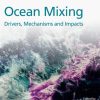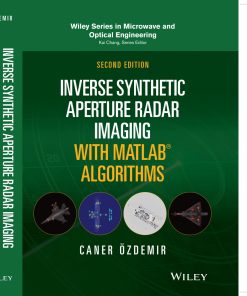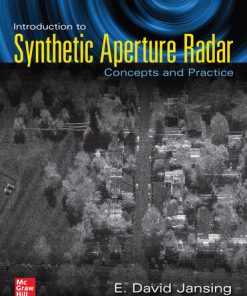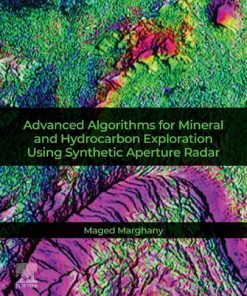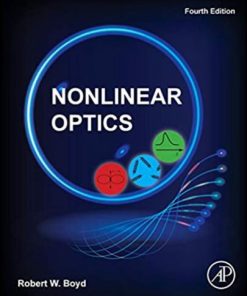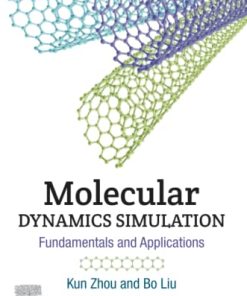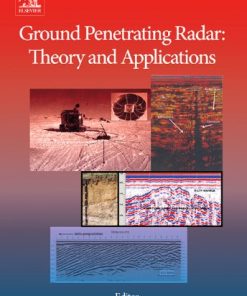Nonlinear Ocean Dynamics Synthetic Aperture Radar 1st Edition by Maged Marghany 0128209259 9780128209257
$50.00 Original price was: $50.00.$25.00Current price is: $25.00.
Nonlinear Ocean Dynamics: Synthetic Aperture Radar 1st Edition by Maged Marghany – Ebook PDF Instant Download/DeliveryISBN: 0128209259 9780128209257
Full download Nonlinear Ocean Dynamics: Synthetic Aperture Radar 1st Edition after payment.
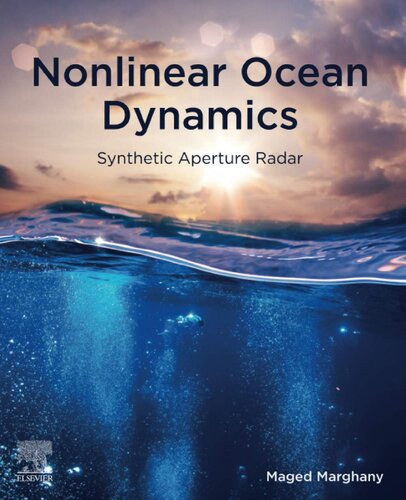
Product details:
ISBN-10 : 0128209259
ISBN-13 : 9780128209257
Author : Maged Marghany
Nonlinear Ocean Dynamics: Synthetic Aperture Radar delivers the critical tools needed to understand the latest technology surrounding the radar imaging of nonlinear waves, particularly microwave radar, as a main source to understand, analyze and apply concepts in the field of ocean dynamic surface. Filling the gap between modern physics quantum theory and applications of radar imaging of ocean dynamic surface, this reference is packed with technical details associated with the potentiality of synthetic aperture radar (SAR). The book also includes key methods needed to extract the value-added information necessary, such as wave spectra energy, current pattern velocity, internal waves, and more. This book also reveals novel speculation of a shallow coastal front: named as Quantized Marghany’s Front.
Nonlinear Ocean Dynamics: Synthetic Aperture Radar 1st Table of contents:
Chapter 1: Nonlinear ocean motion equations: Introduction and overview
Abstract
1.1: Introduction
1.2: What is meant by ocean dynamics?
1.3: What is meant by nonlinear?
1.4: Classification of ocean dynamic flows
1.5: Ocean dynamic circulation
1.6: What is the difference between circulation and vorticity?
1.7: Primitive equation of ocean dynamics
1.8: Navier-Stokes equations
1.9: Turbulence
1.10: Equations of motion in a rotating frame
1.11: Conservation equation of ocean waves
1.12: Water level exchange and water flow
1.13: Dispersion relation for water waves
1.14: Nonlinear water flow and wave propagation
1.15: Energy equation of fluid flow
Chapter 2: Quantization of ocean dynamics
Abstract
2.1: Seawater quantum molecules
2.2: Ocean dynamics mimic quantum mechanics
2.3: Similarities and differences between quantum field theory and ocean dynamics
2.4: Quantum spin of seawater
2.5: Kitaev spin seawaters
2.6: Hamiltonian mechanics for ocean dynamics
2.7: Incompressible flow with Schrödinger equations
2.8: Quantum mechanics of Coriolis force
2.9: Quantization of barotropic flow
2.10: Quantization of vorticity flow
2.11: Quantum turbulence
2.12: Particle theory of ocean waves
2.13: Schrödinger equation for description of nonlinear Sea-state
2.14: Hamiltonian formulation for water wave equation
Chapter 3: Quantization of synthetic aperture microwave radar
Abstract
3.1: Quantize concept of aperture
3.2: Aperture antenna
3.3: Quantization of electromagnetic wave and Maxwell’s equations
3.4: Microwave radar photons
3.5: Microwave cavity main concept
3.6: Microwave photon generation by Josephson junctions
3.7: Radar systems
3.8: What is meant by echolocation detecting and ranging?
3.9: Why quantum synthetic aperture radar is necessary
3.10: What is meant by quantum SAR?
3.11: What are the classifications of quantum SAR?
3.12: Classical and quantum radar equations
3.13: Quantum SAR illumination
3.14: Quantum theory of SAR system
Chapter 4: Quantum mechanism of nonlinear ocean surface backscattering
Abstract
4.1: What is meant by scattering?
4.2: Comparison between coherent and incoherent multiple scattering
4.3: What is the role of spin in understanding scattering?
4.4: Spin of scattering of particles
4.5: Scattering of identical particles
4.6: Schrödinger equation for scattering particles
4.7: How do the Lippmann-Schwinger equation and the scattering amplitude generalize when spin is included?
4.8: Seawater atom-photon scattering
4.9: Scattering from roughness surface
4.10: Mathematical depiction of SAR backscattering cross-section
4.11: Wave function of SAR backscattering cross-section
4.12: Quantization of Bragg scattering
Chapter 5: Relativistic quantum mechanics of ocean surface dynamic in synthetic aperture radar
Abstract
5.1: What is meant by relativity?
5.2: Relativistic quantum mechanics versus ordinary quantum mechanics
5.3: SAR backscatter in relativistic quantum mechanics
5.4: Duality of wave packages in relativistic quantum mechanics
5.5: Relativities of SAR time pulse range traveling
5.6: SAR space-time invariance interval
5.7: How is quantum entanglement consistent with the time relativity?
5.8: SAR time dilation
5.9: SAR length contraction in polarized data
Chapter 6: Novel relativistic theories of ocean wave nonlinearity imagine mechanism in synthetic aperture radar
Abstract
6.1: What is meant by waves and flows?
6.2: Description of ocean waves
6.3: How sea waves are formed based on Spooky Action at a Distance
6.4: What is doing the waving?
6.5: Hamiltonian formula for nonlinear wave description
6.6: SAR image mechanism for ocean wave
6.7: Relativistic theory of SAR velocity bunching
6.8: Relativistic theory of the ocean wavelength in SAR images
6.9: Relativistic theory of incidence angle in SAR wave images
6.10: Relativistic theory of range bunching
Chapter 7: Quantum nonlinear techniques for retrieving ocean wave spectral parameters from synthetic aperture radar
Abstract
7.1: Simplification of the magic concept of SAR Doppler shift frequency
7.2: SAR sensors for ocean wave simulation
7.3: Sea surface backscatter based on the Kirchhoff approximation
7.4: Imaging Ocean wave parameters in single polarization SAR data
7.5: How to relate wave fields to SAR images
7.6: SAR wave retrieval algorithms
7.7: Quantum spectra estimation using quantum Fourier transform
7.8: Multilooking and cross-spectral analysis
7.9: Quantum Monte Carlo wave spectral simulation
7.10: SAR wave spectra simulated using diffusion quantum Monte Carlo
Chapter 8: Polarimetric synthetic aperture radar for wave spectra refraction using inversion SAR wave spectra model
Abstract
8.1: What is meant by polarimetric synthetic aperture radar?
8.2: Polarimetric matrix formulations and SAR data representation
8.3: The coherency matrix THV (for single-look or multilook)
8.4: Circular polarization-based covariance matrix CRL
8.5: Estimation of azimuth slopes using orientation angle
8.6: Alpha parameter sensitivity to the range of traveling waves
8.7: Examined POLSAR and AIRSAR data
8.8: Wave spectra model
8.9: Two-dimensional quantum Fourier transform for retrieving SAR wave spectra
8.10: Quasilinear transform
8.11: Modeling significant wave height using azimuth cutoff model
8.12: AIRSAR/POLSAR cross-spectrum inversion
8.13: Differences between deep and shallow water waves
8.14: Quantum of wave refraction
8.15: Wave refraction graphical method
Chapter 9: Wavelet transform and particle swarm optimization algorithms for automatic detection of internal wave from synthetic aperture radar
Abstract
9.1: Introduction
9.2: What is meant by internal wave?
9.3: Simplification of internal wave generation mechanisms
9.4: Mathematical description of internal waves
9.5: Kelvin-Helmholtz instability
9.6: Internal wave imaging in SAR
9.7: Internal wave radar backscatter cross-section
9.8: Internal wave detection using two-dimensional wavelet transform
9.9: Particle swarm optimization (PSO) algorithm
9.10: Tested SAR data
9.11: Backscatter distribution along with internal wave in SAR data
9.12: Automatic detection of internal wave using two-dimensional wavelet transform
9.13: Internal wave packet detection by PSO
9.14: Why do internal waves occur in the Andaman Sea?
Chapter 10: Modeling wave pattern cycles using advanced interferometry altimeter satellite data
Abstract
10.1: Microwave altimeter
10.2: Principles of altimeters
10.3: Types of radar altimeter frequencies
10.4: How does a radio altimeter work?
10.5: How is surface height estimated by radio altimeter?
10.6: Pulse-limited altimetry
10.7: Altimeter sensors
10.8: Principles of synthetic aperture radar altimeter interferometry
10.9: Altimeter interferometry technique
10.10: InSAR precision procedures altimeter scheme
10.11: Delay-Doppler altimeter
10.12: CRYOSAT-2 SIRAL data acquisitions
10.13: Cycle of significant wave heights and powers: Case study of west coast of Australia
Chapter 11: Multiobjective genetic algorithm for modeling Rossby wave and potential velocity patterns from altimeter satellite data
Abstract
11.1: What is meant by Rossby wave?
11.2: Rossby waves algebraic portrayal Coriolis
11.3: Rossby waves causing convergence and divergence zones
11.4: Collinear analysis for modeling Rossby wave patterns from satellite altimeter
11.5: Rossby wave spectra patterns using fast Fourier transform
11.6: Multiobjective algorithm for modeling Rossby waves in altimeter data
11.7: Rossby wave population of solutions
11.8: Fitness procedures for simulation of Rossby wave patterns
11.9: Cross-over and mutation for Rossby wave reconstruction from altimeter data
11.10: Velocity potential patterns in the southern Indian Ocean from Jason-2
11.11: Pareto algorithm simulation of water parcel sinking due to vorticity potential velocity
11.12: How can Rossby waves mobilize water mass parcels and heavy debris?
Chapter 12: Nonlinear sea surface current mathematical and retrieving models in synthetic aperture radar
Abstract
12.1: Introduction
12.2: What is meant by ocean current?
12.3: Ocean current theory
12.4: Ocean current measurements
12.5: Governing equations of inviscid motion
12.6: Wind-driven current
12.7: Ekman spiral
12.8: Quantum theory of the Ekman spiral
12.9: SAR Doppler shift frequency
12.10: SAR Doppler frequency shift model formulation
12.11: Radial current velocity based on Doppler spectral intensity
12.12: Robust model for simulating surface current in SAR imaging
12.13: Tidal current direction estimation
12.14: Ocean current retrieving from SAR data, case study: East coast of Malaysia
12.15: Quantization of large scale eddy in SAR image
Chapter 13: Relativistic quantum of nonlinear three-dimensional front signature in synthetic aperture radar imagery
Abstract
13.1: What is meant by quantum coastal front?
13.2: Signature of a front in a single SAR image
13.3: Relativity of front signatures in polarimetric SAR
13.4: How does the tidal cycle effect front signature in SAR images?
13.5: Speckles impact on front signature in SAR images
13.6: Anisotropic diffusion algorithm for speckle reductions
13.7: 3-D front model
13.8: 3-D front topology reconstruction in SAR data
13.9: Quantized Marghany’s front
Chapter 14: Automatic detection of nonlinear turbulent flow in synthetic aperture radar using quantum multiobjective algorithm
Abstract
14.1: Introduction
14.2: What is meant by quantum turbulence?
14.3: Turbulence imagined in SAR data
14.4: Can a quantum algorithm automatically detect turbulent flow in SAR images?
14.5: Quantum computing
14.6: Quantum machine learning
14.7: Quantum multiobjective evolutionary algorithm (QMEA)
14.8: Generation of qubit populations
14.9: Generation of turbulent flow population pattern
14.10: Quantum nondominated sort and elitism (QNSGA-II)
14.11: Quantum Pareto optimal solution
14.12: Automatic detection of turbulent flow in SAR images
14.13: Role of Pareto optimization in QNSGA-II
14.14: Quantum coherence of turbulent flow magnitudes in SAR imaging and QNSGA-II
Chapter 15: Four-dimensional along-track interferometry for retrieving sea surface wave-current interaction
Abstract
15.1: What is meant by four-dimensional and why?
15.2: Does n-dimensional exist?
15.3: Physics of Interferometry
15.4: What is synthetic aperture interferometry?
15.5: Interferograms
15.6: Phase unwrapping
15.7: Understanding SAR interferograms
15.8: Along-track interferometry
15.9: Quantum of along-track interferometry
15.10: Quantum Hopfield algorithm for ATI phase unwrapping
15.11: Quantum ATI Hopfield algorithm application to TanDEM-X satellite data
15.12: In situ measurement
15.13: Retrieving current from ATI TanDEM-X satellite data using qHop algorithm
15.14: Four-dimensional ATI quantum algorithm for wave-current interaction
15.15: 4-D visualization of wave-current sea level interactions
15.16: Relativistic quantum 4-D of sea surface reconstruction in TanDEM data
People also search for Nonlinear Ocean Dynamics: Synthetic Aperture Radar 1st:
nonlinear dynamics definition
nonlinear dynamics examples
nonlinear dynamics course
non linear ocean dynamics
nonlinear dynamics occur because
Tags:
Nonlinear Ocean,Dynamics,Synthetic Aperture,Maged Marghany
You may also like…
Engineering
Inverse Synthetic Aperture Radar Imaging With MATLAB Algorithms 2nd Edition Caner Ozdemir
Politics & Philosophy - Anthropology
Engineering
Science (General)
Physics - Others
Engineering - Electrical & Electronic Engineering



